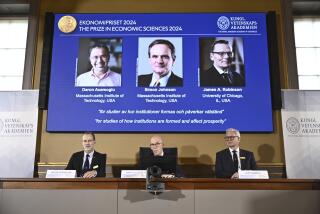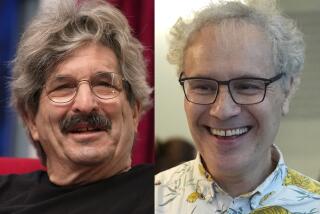3 Americans win Nobel Prize in medicine for uncovering the science behind our biological clocks

Winners of the 2017 Nobel Prize in Physiology or Medicine Jeffrey C. Hall, Michael Rosbash and Michael W. Young are pictured on a display during a press conference at the Karolinska Institute in Stockholm on Oct. 2, 2017.
- Share via
A trio of American scientists was awarded the Nobel Prize in physiology or medicine for revealing the mechanisms of the cellular clock that regulates biological changes in complex organisms across a 24-hour span.
Working at Brandeis University in the 1980s, Jeffrey C. Hall and Michael Rosbash uncovered the genetic basis of circadian rhythms in fruit flies. Michael W. Young collaborated with Hall and Rosbash from Rockefeller University to isolate the key gene, which had been named “period” by scientists who had surmised its existence.
Hall, Rosbash and Young would go on to discover a variety of genetic and cellular mechanisms that keep the circadian clocks of living things ticking in sync with the Earth’s daily rotation.
Rosbash remains on the faculty at Brandeis University in Waltham, Mass., where Hall is a professor emeritus of biology. Young is still at Rockefeller University in New York City.
For some years, a team led by Hall and Rosbash competed against a team led by Young to be the first to clone the genes the group discovered. But the threesome, now friends, have been widely recognized as the co-discoverers of the genetic mechanism underlying the circadian clock in complex organisms.
They were awarded the Hong Kong-based Shaw Prize in life sciences and medicine in 2013, an honor that may have paved the way for the Nobel Committee’s recognition.
The work honored Monday sheds light on how all multicellular creatures undergo regular changes in body temperature, hormones, metabolism and behavior that keep time with different phases of the day.
While the scientists conducted much of their pioneering work on fruit flies, the circadian clock is a powerful factor in human health as well. It helps explain how jet lag and other disruptions to our evolved cycles of sleeping and waking can wear us down and contribute to disease.
Their research has laid the foundation for research into how the time of day influences everything from the way we think to how our bodies store calories or respond to medications. In a world that’s open for business 24/7, research has shown that people who try to defy their circadian rhythms will eventually come up against the biological limits of their cells’ internal clocks.
“Since the seminal discoveries by the three laureates, circadian biology has developed into a vast and highly dynamic research field, with implications for our health and well-being,” the Nobel committee said in its announcement Monday in Stockholm, Sweden.
Dr. Francis S. Collins, director of the National Institutes of Health, said the trio’s work “is informing treatments for sleep disorders, obesity, mental health disorders, and other health problems.” The NIH has invested more than $30 million in their studies.
The work also underscores the sustained influence of our common environment on creatures up and down the evolutionary ladder. The genetic mechanisms that keep fruit flies on a 24-hour cycle governed by day and night are the same as those for humans.
The research is “a great example of how studying fundamental biological processes in model organisms such as fruit flies reveals important principles that translate into a deeper understanding of human biology and disease,” said Jon R. Lorsch, director of the NIH’s National Institute on General Medical Sciences.
In its citation for the $1.1-million prize, the Nobel Assembly at Sweden’s Karolinska Institute said the researchers “were able to peek inside our biological clock and elucidate its inner workings.”
That process unfolded in many steps.
Hall, Rosbash and Young isolated the period gene in 1984. It would take several more years for Hall and Rosbash to see that the protein encoded by that gene — called PER — went through a daily cycle of accumulating during the night and depleting over the course of the day.
How was that rhythm sustained? Hall and Rosbash surmised that some feedback loop was at work, whereby the buildup of PER protein inside the cell might dial down the period gene’s activity. But they puzzled over how that shutoff signal was sent from the cytoplasm, where PER protein was produced, to the cell nucleus, where the genetic machinery was located.
That mystery was solved in 1994, with Young’s discovery of a second clock gene, which he called “timeless.” That gene also appeared to be required for organisms to maintain normal circadian rhythm, by encoding the production of a protein called TIM.
Young’s “elegant work,” the Nobel Committee wrote, showed that when the TIM and PER proteins were bound together, they were able to enter the cell nucleus. There, they blocked the activity of the period gene and closed the feedback loop.
Over time, Young would go on to find a third timekeeper gene, which he dubbed “doubletime,” that would allow a more precise alignment of protein levels with a 24-hour cycle. Hall, Rosbash and Young have identified additional proteins required for the activation of the period gene, as well as for the mechanism by which light can synchronize the clock.
Rosbash explained that the day-night cycle was the original environmental influence on humans and other living beings.
“Before the atmosphere has its current constitution and before nutrition was anything like it is today, the Earth rotated on its axis and the light-dark cycle impinged on the beginnings of life,” he said Monday in an interview with Nobel officials.
Rosbash added that when he received the pre-dawn call from Stockholm, he was so shocked that his wife had to remind him to breathe.
Young, too, said he struggled to digest the news.
“I’d go and I’d pick up the shoes, and then I’d realize I need the socks,” he said during a news conference. “And then I realized I needed to put my pants on first.”
The award brings the number of U.S.-born Nobel laureates to 259.
Twitter: @LATMelissaHealy
MORE IN SCIENCE
Once harmless, the Zika virus became lethal after a single genetic mutation took hold around 2013
Abortions: easier to obtain than ever, yet nearly half worldwide are deemed unsafe, study finds
Scientists may have found a way to diagnose CTE in football players while they’re still alive
UPDATES:
5:05 p.m.: This article was updated with additional comments from the winners and other scientists.
8:25 a.m.: This article was updated throughout with staff reporting.
This article was originally published at 2:50 a.m.







